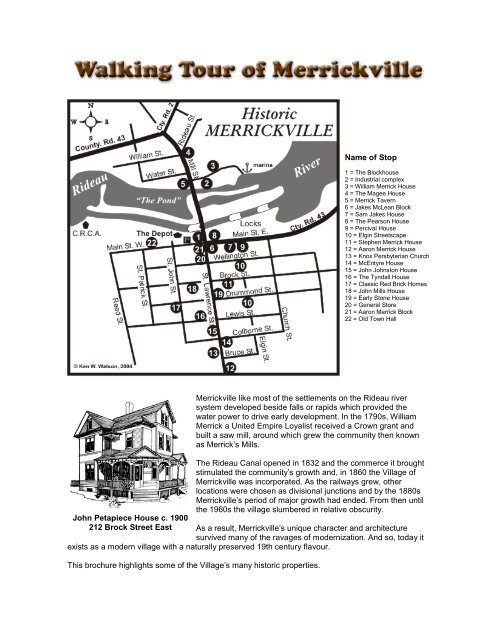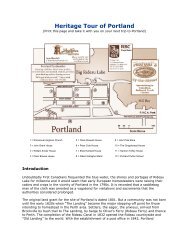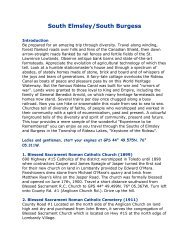Merrickville - Rideau Heritage Route
Merrickville - Rideau Heritage Route
Merrickville - Rideau Heritage Route
You also want an ePaper? Increase the reach of your titles
YUMPU automatically turns print PDFs into web optimized ePapers that Google loves.
Name of Stop<br />
1 = The Blockhouse<br />
2 = Industrial complex<br />
3 = William Merrick House<br />
4 = The Magee House<br />
5 = Merrick Tavern<br />
6 = Jakes McLean Block<br />
7 = Sam Jakes House<br />
8 = The Pearson House<br />
9 = Percival House<br />
10 = Elgin Streetscape<br />
11 = Stephen Merrick House<br />
12 = Aaron Merrick House<br />
13 = Knox Persbyterian Church<br />
14 = McEntyre House<br />
15 = John Johnston House<br />
16 = The Tyndall House<br />
17 = Classic Red Brick Homes<br />
18 = John Mills House<br />
19 = Early Stone House<br />
20 = General Store<br />
21 = Aaron Merrick Block<br />
22 = Old Town Hall<br />
John Petapiece House c. 1900<br />
212 Brock Street East<br />
<strong>Merrickville</strong> like most of the settlements on the <strong>Rideau</strong> river<br />
system developed beside falls or rapids which provided the<br />
water power to drive early development. In the 1790s, William<br />
Merrick a United Empire Loyalist received a Crown grant and<br />
built a saw mill, around which grew the community then known<br />
as Merrick’s Mills.<br />
The <strong>Rideau</strong> Canal opened in 1832 and the commerce it brought<br />
stimulated the community’s growth and, in 1860 the Village of<br />
<strong>Merrickville</strong> was incorporated. As the railways grew, other<br />
locations were chosen as divisional junctions and by the 1880s<br />
<strong>Merrickville</strong>’s period of major growth had ended. From then until<br />
the 1960s the village slumbered in relative obscurity.<br />
As a result, <strong>Merrickville</strong>’s unique character and architecture<br />
survived many of the ravages of modernization. And so, today it<br />
exists as a modern village with a naturally preserved 19th century flavour.<br />
This brochure highlights some of the Village’s many historic properties.
1. The Blockhouse 1832, Main & St Lawrence<br />
Built to defend the canal, this is the largest of the four such<br />
military stone blockhouses built for this purpose. Once serving as<br />
the home and residence for lockmaster John Johnston, it now is a<br />
Museum operated by the <strong>Merrickville</strong> & District Historical Society.<br />
Inside it houses a collection of typical 19th century implements.<br />
2. The Industrial Complex 1790<br />
On the north side of the bridge is the site of the industrial complex<br />
which grew around William Merrick’s original sawmill. By the early<br />
1800s, flour and grist mills had been added, and by 1850 a major<br />
foundry and woollen mill were part of the complex.<br />
3. *William Merrick House c. 1821 - 129 Mill Street<br />
The third and last home of the Village founder and pioneer<br />
industrialist William Merrick. It was later owned by industrialist and<br />
foundryman William Pearson and his daughter Mary Pearson.<br />
4. *The Magee House c. 1845 - 205 Mill Street<br />
Built in the 1840s and acquired shortly thereafter by early<br />
foundryman William Magee,<br />
this Queen Anne style<br />
Victorian is one of the most attractive homes in the Village.<br />
Carefully restored it is now operated as the “Millisle B&B”.<br />
5. *Merrick Tavern c. 1830 - 106 Mill Street<br />
One of the earliest surviving buildings in the Village, this stone<br />
house was a tavern owned by Terrance & Aaron Merrick. It<br />
served the mill workers from the industrial complex across the<br />
street. In 1980 it was restored as a private home.<br />
6. *Jakes McLean Block c.1862 - Main & St Lawrence SE<br />
The largest commercial building in <strong>Merrickville</strong> was built and served as a department store, one of<br />
the grandest in the region. During the 1940s entrepreneur Harry F McLean acquired it for his<br />
company offices. It now houses retail shops, a pub named for Harry McLean and the Baldachin<br />
dining and hospitality operations.<br />
7. *Sam Jakes House c. 1861 - 118 Main Street E<br />
Originally built as the home of prominent merchant, Samuel Jakes, this solid stone structure now<br />
serves as the reception and dining area for the four star Sam Jakes<br />
Inn.<br />
8. *The Pearson House c. 1890 - 111 Main Street E<br />
Donated by Miss Mary Pearson to the Village in 1938 this early<br />
Victorian home is now, the <strong>Merrickville</strong> public Library.<br />
9. *Percival House c. 1890 - 206<br />
Main Street E<br />
The Richardsonian-Romanesque<br />
style home of foundryman Roger Percival. Note the new “coach<br />
house” built in the style of the original house.<br />
10. Elgin Streetscape 1820-1920<br />
The five blocks on Elgin Street, between Wellington and Bruce
present a parade of architectural evolution from the early 19th to 20th centuries. The Duke house at<br />
*206 Elgin circa 1855 has covered its original logs with wooden<br />
shipboard siding. Across the street, the stone liquor store was the<br />
1860 foundry of H D Smith. At *306 Elgin the elegant wooden<br />
cross gabled home was built by Samuel Langford as a wedding<br />
gift for his daughter. At Drummond, note the 1860s, 1 ½ story<br />
clapboard and on the opposite corner a 1920s generic, both<br />
carefully restored. Further up Elgin at Drummond are fine<br />
examples of the red brick houses with colourful yellow brick<br />
quoins and trim, stylish and popular in the 1880s.<br />
k prosperity<br />
11. *Stephen Merrick House c.1850 - 106 Brock St E<br />
One of the finest stone homes in the village, this house was built<br />
by Samuel Langford for Stephen Merrick, a son of village founder<br />
William Merrick. Note the<br />
superior fine cut ashlar stone on<br />
the front façade. an indication of<br />
Merric<br />
12. *Aaron Merrick House c. 1845 - 905 St Lawrence<br />
The ultimate Merrick house built by Aaron Merrick, the son of town founder Wm. Merrick and later<br />
owned by Harry Falconer McLean, Engineer-Contractor, extraordinaire.
13. *Knox Presbyterian Church 1861 - 618 St Lawrence<br />
Restored by <strong>Heritage</strong> <strong>Merrickville</strong> Foundation in 1983 to maintain its<br />
historic presence, this red-brick building, the earliest surviving church<br />
structure, has been preserved for community use as the Knox Hall.<br />
14. *McEntyre House c. 1861 - 605 St Lawrence<br />
Constructed for Daniel McEntyre, a shoemaker, this 1½ storey stone home<br />
with Greek revival details was later used as a millinery shop.<br />
16. *The Tyndall House<br />
c.1855 - 105 Lewis St W<br />
Popularly linked to George<br />
Merrick, grandson of town<br />
father William Merrick this Adamesque style stone house with its<br />
“loyalist” doorway was in the Tyndall family until the end of the<br />
19th century.<br />
15. *John Johnston House c. 1850 -<br />
512 St Lawrence<br />
Built for retired Sergeant John Johnston,<br />
who served as <strong>Merrickville</strong>’s lockmaster from 1837 to 1869, this<br />
stone house, exhibits the classic style of Greek revival. Note the<br />
suicide door, built in anticipation of a porch to be added later.<br />
17. Classic Red Brick Homes<br />
c.1860 - St John & Drummond St<br />
By 1860 <strong>Merrickville</strong> produced brick was replacing stone as a<br />
preferred building material. These two homes demonstrate more<br />
elaborate trim and steeply pitched gable begin to appear at this<br />
time previewing the coming Victorian style.<br />
of roof fires to neighbours.<br />
18. *John Mills House c.1860 - 130 Brock Street W<br />
Constructed as a store and furniture factory by cabinet maker<br />
John Mills. Note the parapetted end gables to help prevent spread<br />
19. Early Stone House c.1830 - 323 St Lawrence<br />
Probably built about 1830, before the canal, this recently renovated, largely rubble and stucco<br />
structure is one of the earliest remaining stone houses in the Village.<br />
20. *General Store c. 1848-1855 - 136 St Lawrence<br />
Until recently a stucco finish hid the cut stone details of this building. It was built as a general store<br />
about 1848 by an early <strong>Merrickville</strong> merchant, Charles Holden. The building has since served<br />
continuously as a retail outlet.<br />
21. *Aaron Merrick Block c. 1856 - St. Lawrence<br />
Commissioned by Aaron Merrick, this massive three story stone structure was built to proclaim and<br />
house <strong>Merrickville</strong>’s early commercial interests. From the mid 1800s until the early years of the 20th<br />
century it was operated by the Tallman family as a grand scale general store. Like much of the<br />
Village it fell into disrepair until renovations began in 1974. As a counterpoint to the Jakes block<br />
across the street, it now houses apartments, offices and several of the Village’s attractive retail<br />
shops.<br />
22. *Old Town Hall c. 1856
Designed by Samuel Langford and constructed in 1856 by the township of Wolford, and later<br />
transferred in 1860 to the Village of <strong>Merrickville</strong>, this stalwart stone three story building with its wide<br />
open second and third story spaces was ideally suited for public administration, political events and<br />
community gatherings. Used as such it served the community for over 100 years. By the early<br />
1970’s it was abandoned but kept from total deterioration by private owners. In 1984 the building<br />
was acquired by the <strong>Heritage</strong> <strong>Merrickville</strong> Foundation which, with funding from private, corporate and<br />
government sources, conducted badly needed renovations. The Foundation continues to own the<br />
building and has made this important historic structure available for community and commercial<br />
endeavours.<br />
Properties indicated with an asterisk * are among the 33 Village properties that have been<br />
designated “historic” through LACAC under the Ontario <strong>Heritage</strong> Act 1974<br />
For more complete descriptions and a map please see the Walking Tour Booklet available for<br />
purchase at the Blockhouse Museum and many Village merchants<br />
©2004 The <strong>Merrickville</strong> & District<br />
Produced with support from the <strong>Merrickville</strong> <strong>Heritage</strong> Foundation<br />
Illustrations by Graham Thomas<br />
Brochure Design by John Cowan<br />
Text from July 2004 version of the brochure.<br />
Web version created in 2004 by Ken W. Watson.








